If you’re familiar with travel food blogs, you’ll know the thrill of diving into local cuisine. For many, this culinary adventure includes street food, which, let’s face it, sometimes has a questionable reputation for hygiene, especially in places like the Philippines.
Growing up in Manila, we were often told to be wary of Filipino street food, warned about its supposed unsanitary nature. If you’re from Manila, you’ve likely heard the same urban myths about “dirty” Pinoy Street Food, and perhaps, like us, you might have avoided it altogether.
But here’s a thought: if Pinoy street food is supposedly so unsafe, why do we happily indulge in street food when we travel abroad? The bustling streets of Hanoi, the vibrant hawker centers of Penang, and the packed food stalls of Hong Kong aren’t necessarily cleaner than Manila’s sidewalks. Yet, there we are, with gusto, enjoying bowls of noodles and skewers of grilled meats without a second thought. And surprisingly, we’ve never gotten sick.
This begs the question: are we being unfair to Pinoy street food? Are the horror stories exaggerated? Is it all just a big myth perpetuated by fancy restaurants?
These are the questions we aimed to answer. Like returning Filipinos eager to reconnect with their roots, we ventured into the streets of Manila to rediscover – or perhaps, discover for the first time – our love for Pinoy street food. Here’s what we found on our delicious journey.
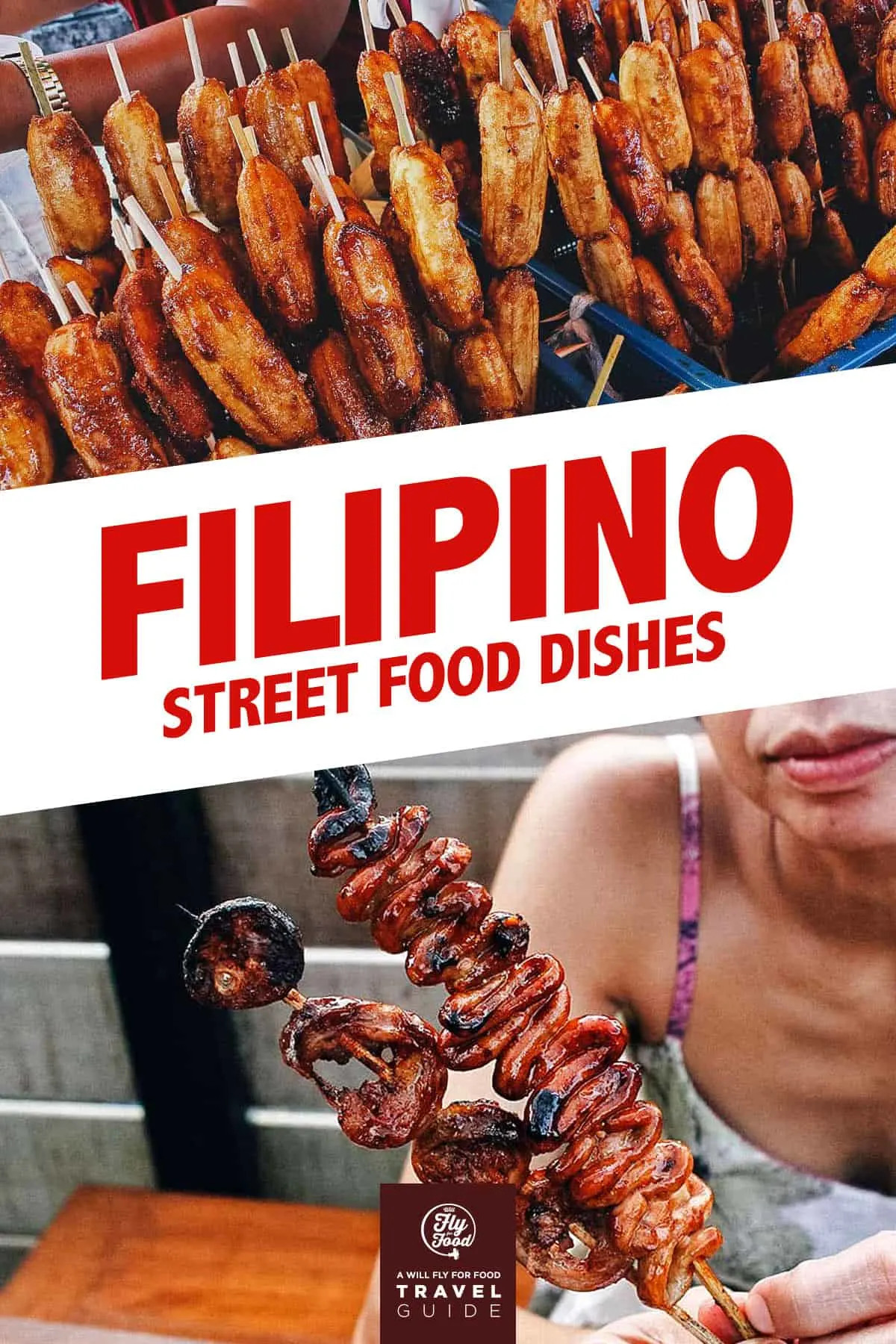 Banana Q
Banana Q
Pinoy Street Food: A Culinary Adventure
1. Balut
Starting our list alphabetically, we inevitably begin with balut, arguably the most talked-about and intriguing Pinoy street food.
For those unfamiliar, balut is a developing duck embryo, incubated for 14 to 21 days, then boiled and eaten straight from the shell. Duck eggs, especially from native or Pateros ducks, are traditionally used, though chicken eggs can be substituted if necessary.
When it comes to unique and adventurous Filipino dishes, balut often tops the list. It’s a true test for the daring foodie exploring Philippine cuisine.
Having grown up eating balut, I personally don’t find it strange at all. However, many Filipinos, and certainly many foreigners, do find the idea off-putting. My partner, for instance, enjoys the broth and yolk but avoids the embryo itself.
The stage of embryonic development varies depending on the incubation period. Seventeen days is considered ideal, at which point the embryo is soft and mostly unformed, except for faint feather outlines.
However, you might encounter balut with more developed embryos, resembling miniature ducklings. These can have tougher bones and beaks, making them challenging even for seasoned balut eaters. Once, I recall eating one with a beak that was too hard and had to be spat out!
Balut is often seasoned with salt or a mixture of chili, garlic, and vinegar. I prefer it plain. Filipinos are aware of balut’s shock value for tourists and often playfully challenge them to try it. Many politely decline.
You might also encounter “penoy,” which are balut eggs that fail to develop properly after 9-12 days. Penoy resembles a hard-boiled egg with a uniform texture, like a semi-scrambled egg within the shell. For me, nothing beats a properly developed balut.
RECIPE: Sizzling balut
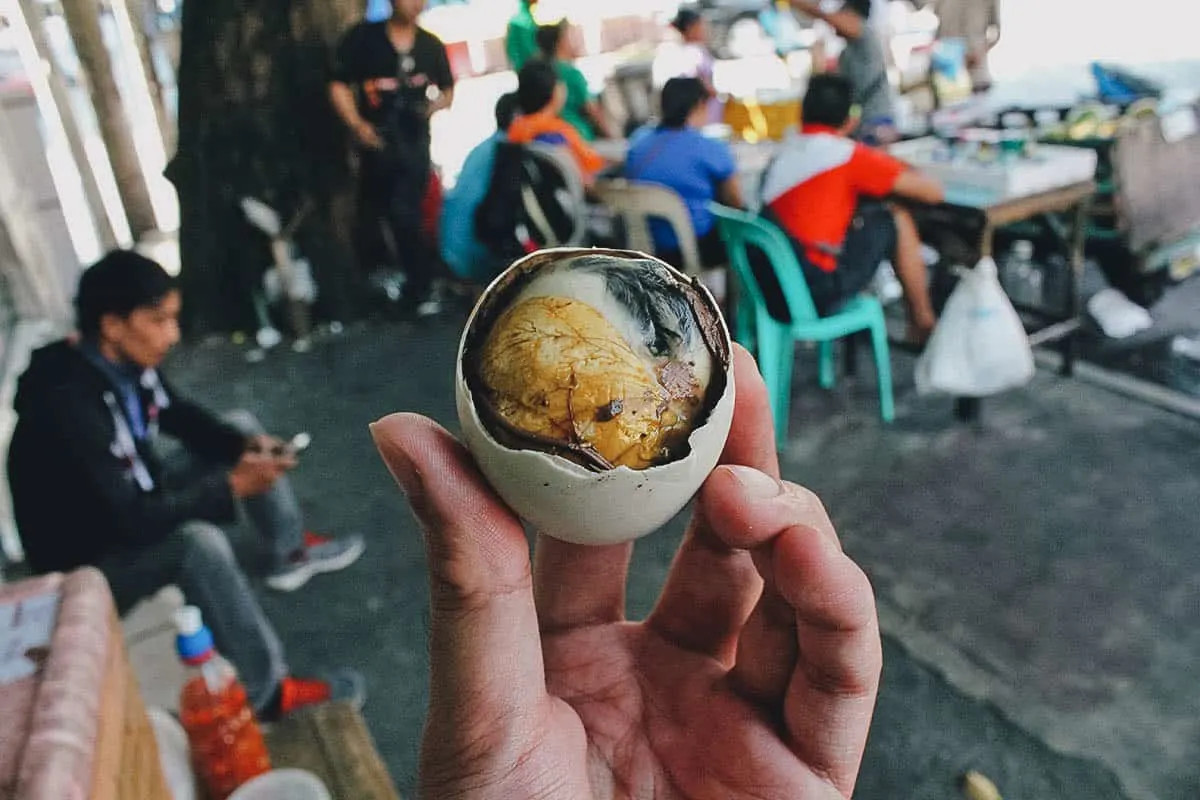 Close up of a Filipino Balut dish served on a white plate, showcasing the fertilized duck egg delicacy.
Close up of a Filipino Balut dish served on a white plate, showcasing the fertilized duck egg delicacy.
2. Banana Q / Kamote Q
In stark contrast to balut, Banana Q (or cue) is universally appealing. This popular Pinoy street food consists of skewered saba bananas, deep-fried and coated in caramelized brown sugar. It’s a nostalgic treat many Filipinos grew up enjoying.
RECIPE: Banana Q
 Three sticks of Filipino Banana Q street food, showcasing caramelized bananas on skewers.
Three sticks of Filipino Banana Q street food, showcasing caramelized bananas on skewers.
While my partner avoided the balut, she eagerly devoured the banana q. As mentioned, banana q is a beloved merienda (mid-afternoon snack) or after-school treat for Filipinos, evoking fond childhood memories. It’s a comforting Filipino snack that brings us back to simpler times.
 A woman smiles while holding a stick of Filipino Banana Q, ready to enjoy the sweet street food.
A woman smiles while holding a stick of Filipino Banana Q, ready to enjoy the sweet street food.
Saba bananas are the key ingredient in banana q. They are also frequently used in Filipino desserts like turon, halo-halo, minatamis na saging (bananas in caramel sauce), and maruya (banana fritters). They even add a touch of sweetness to savory dishes like arroz a la cubana and pochero.
Interestingly, Filipinos even have banana ketchup made from saba bananas. This sweetened version of ketchup emerged during WWII due to tomato shortages. Today, it rivals tomato ketchup in popularity and is the perfect condiment for fried, oily foods.
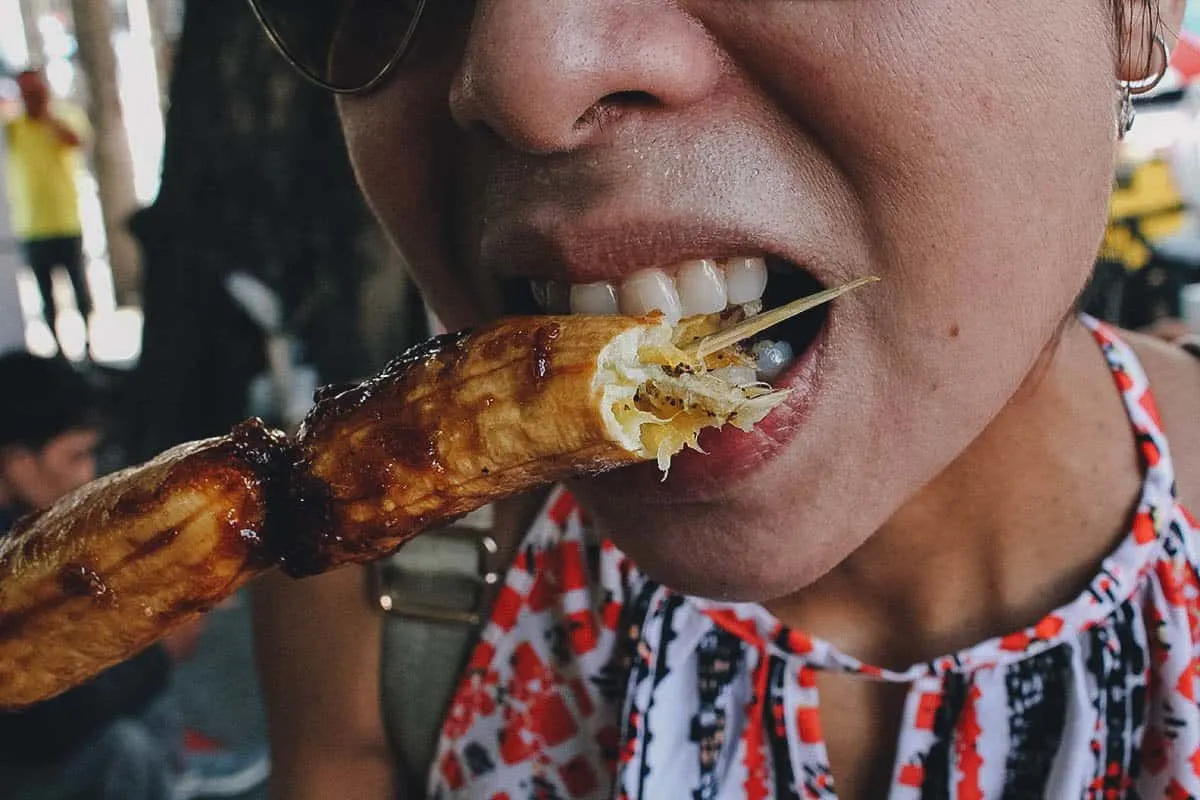 Close-up shot of Filipino Banana Q street food, highlighting the golden brown caramelized sugar coating.
Close-up shot of Filipino Banana Q street food, highlighting the golden brown caramelized sugar coating.
Kamote q is a variation of banana q, using camote or sweet potato instead of bananas. This offers a slightly different flavor profile but maintains the same delicious caramelized sweetness.
 Two sticks of Filipino Kamote Q street food, featuring caramelized sweet potato on skewers.
Two sticks of Filipino Kamote Q street food, featuring caramelized sweet potato on skewers.
3. Buko
Buko is the Tagalog word for young coconut. Although I’ve spent most of my life in the Philippines, I never thought of buko as street food, but arguably it is. Fresh buko, sold from wooden pushcarts, is a common sight across the Philippines, even in bustling cities like Manila.
Buko vendors skillfully hack open the coconut right in front of you, serving it with a straw for immediate refreshment. For those wanting something more, vendors also offer buko juice, a sweet concoction of fresh buko juice, condensed milk, and tender strands of young coconut meat.
Personally, I prefer the latter, especially chilled, but fresh buko juice is incredibly refreshing even at room temperature.
Growing up, I wasn’t aware of the health benefits of buko juice. Beyond hydration, it’s believed to help prevent kidney stones, regulate blood sugar and blood pressure, and aid digestion.
RECIPE: Buko pandan
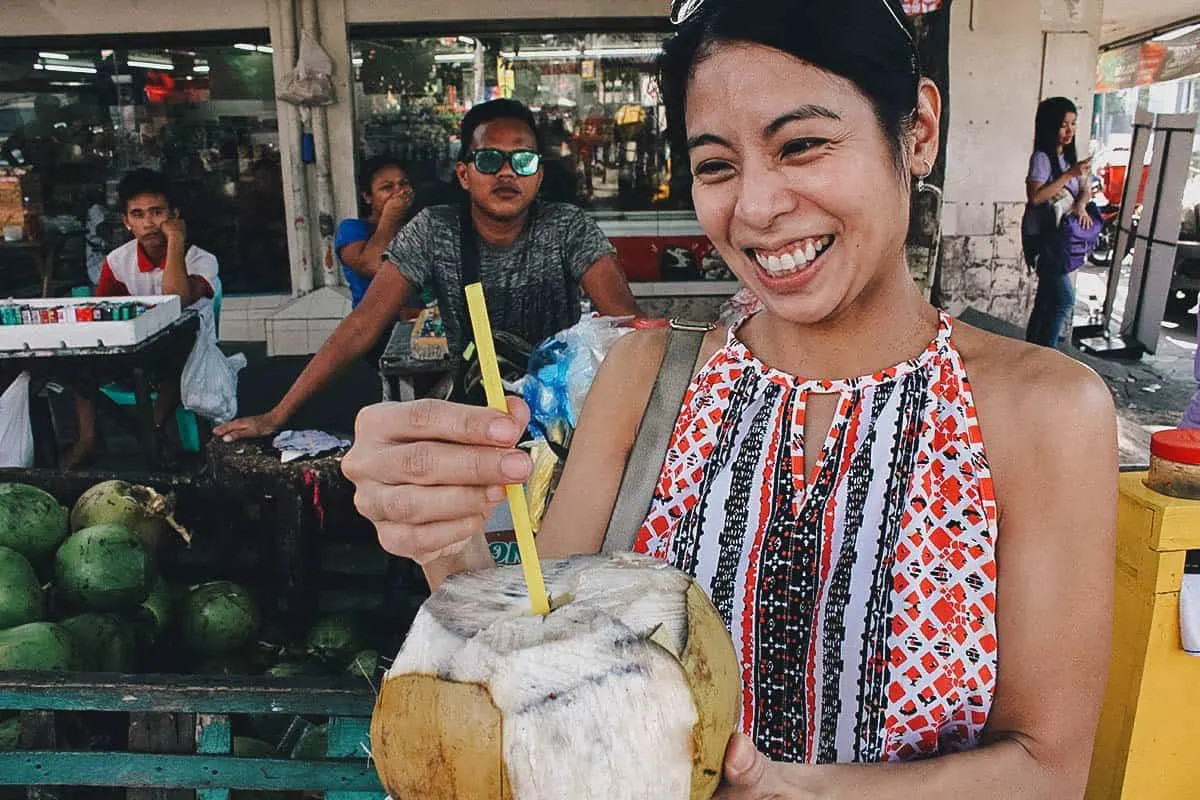 A fresh young coconut, or Buko, displayed as Filipino street food, ready to be opened and enjoyed.
A fresh young coconut, or Buko, displayed as Filipino street food, ready to be opened and enjoyed.
4. Bulaklak
Bulaklak is a unique Pinoy street food, even for locals. Bulaklak refers to pork mesentery or chitterlings – the tissue folds attaching the small intestines to the abdominal wall.
The preparation of bulaklak is what makes it interesting. Typically, it’s deep-fried into chicharon bulaklak, a popular crispy dish.
While chicharon bulaklak is rarely sold as street food, it’s a staple bar snack in the Philippines. Almost any Filipino bar menu will feature it.
However, the version pictured is inihaw na bulaklak, meaning grilled bulaklak. Its origins are unclear, and it’s not as common as chicharon bulaklak.
Like many Filipinos, we grew up with chicharon bulaklak, but we first tasted inihaw na bulaklak a few years ago in Bulacan province. Recently, we’ve noticed it appearing at food park stalls in Manila, suggesting a growing trend.
Unlike the crunchy deep-fried version, inihaw na bulaklak is smoky, less greasy, and equally delicious, especially paired with a cold beer.
RECIPE: Chicharon bulaklak
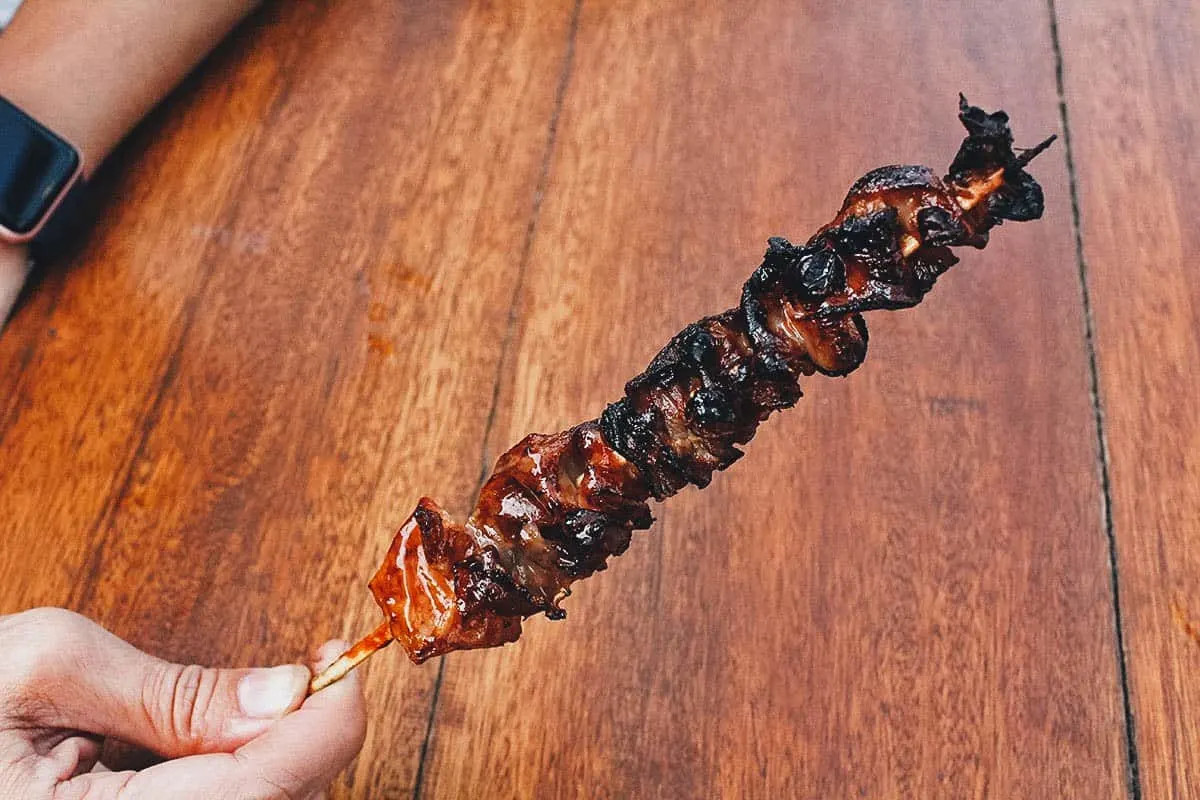 Grilled Filipino Bulaklak street food, featuring pork mesentery cooked over charcoal.
Grilled Filipino Bulaklak street food, featuring pork mesentery cooked over charcoal.
5. Empanada
Like in many Spanish-influenced countries, empanadas are popular in the Philippines. Fillings vary widely, but Filipino empanadas often contain ground meat (beef, pork, or chicken), potatoes, onions, carrots, peas, and raisins, encased in baked or fried dough.
While empanadas might not be ubiquitous street food in Manila, in Vigan, home to the most famous Filipino empanada, they definitely are.
Vigan empanadas stand out with their orange hue and larger size. The color comes from achuete or annatto seeds, also used to color kwek kwek and tokneneng.
Vigan empanadas are deep-fried, resulting in a crispy, shell-like dough, unlike the softer, slightly sweet dough of other Filipino empanadas.
Typical fillings include grated green papaya, mung bean sprouts, shredded carrots, skinless Vigan longganisa (Filipino sausage), and a whole egg.
In the video at the beginning of this article, you can see us tackle a monster Vigan empanada packed with two eggs. Like Vigan ukoy, empanadas are traditionally served with a spiced vinegar dip to cut through the richness.
Until recently, Vigan empanadas were exclusive to Vigan. Thankfully, they’ve become more accessible in Manila, found in food parks and small restaurant chains specializing in Vigan cuisine.
RECIPE: Vigan empanada
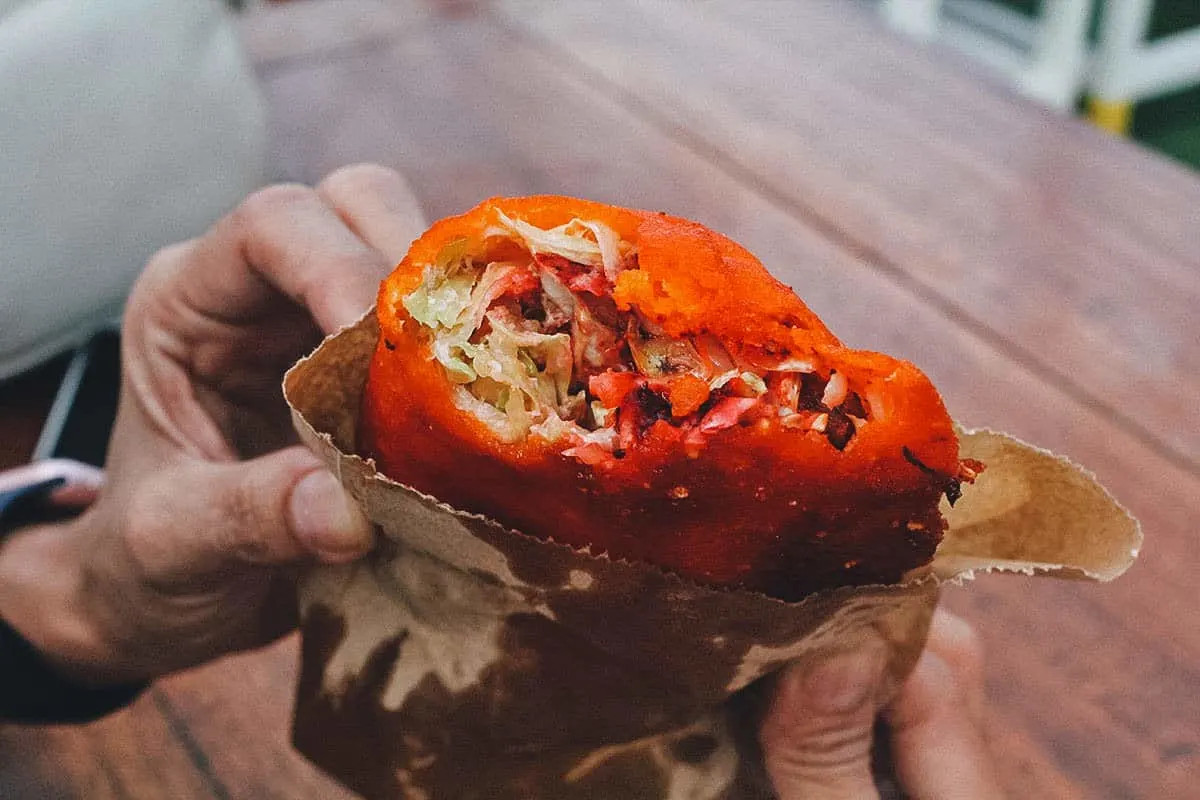 A golden brown Filipino Empanada street food, showcasing the flaky crust and savory filling.
A golden brown Filipino Empanada street food, showcasing the flaky crust and savory filling.
6. Fish Balls / Chicken Balls
If balut is the most infamous Pinoy street food, fish balls are arguably the most iconic. For many Filipinos, fish balls are the quintessential street food, a childhood staple. They are essentially balls of flour with flaked fish meat.
Of all the Pinoy street food we sampled, fish balls were what I was most excited about. Having left for the US at 14, it had been almost 30 years since I last tasted authentic Filipino fish balls.
Unlike banana q or turon, authentic fish balls weren’t easily replicated at home. I remember my mom once bringing home frozen supermarket fish balls, but they just weren’t the same.
Truthfully, the fish balls we had this time were closer to the supermarket variety – crunchier and larger than the soft, flatter fish balls I remember from my school days.
My partner agreed, noting they seemed different from our childhood memories. Perhaps it’s the evolution of Pinoy street food?
RECIPE: Homemade fish balls
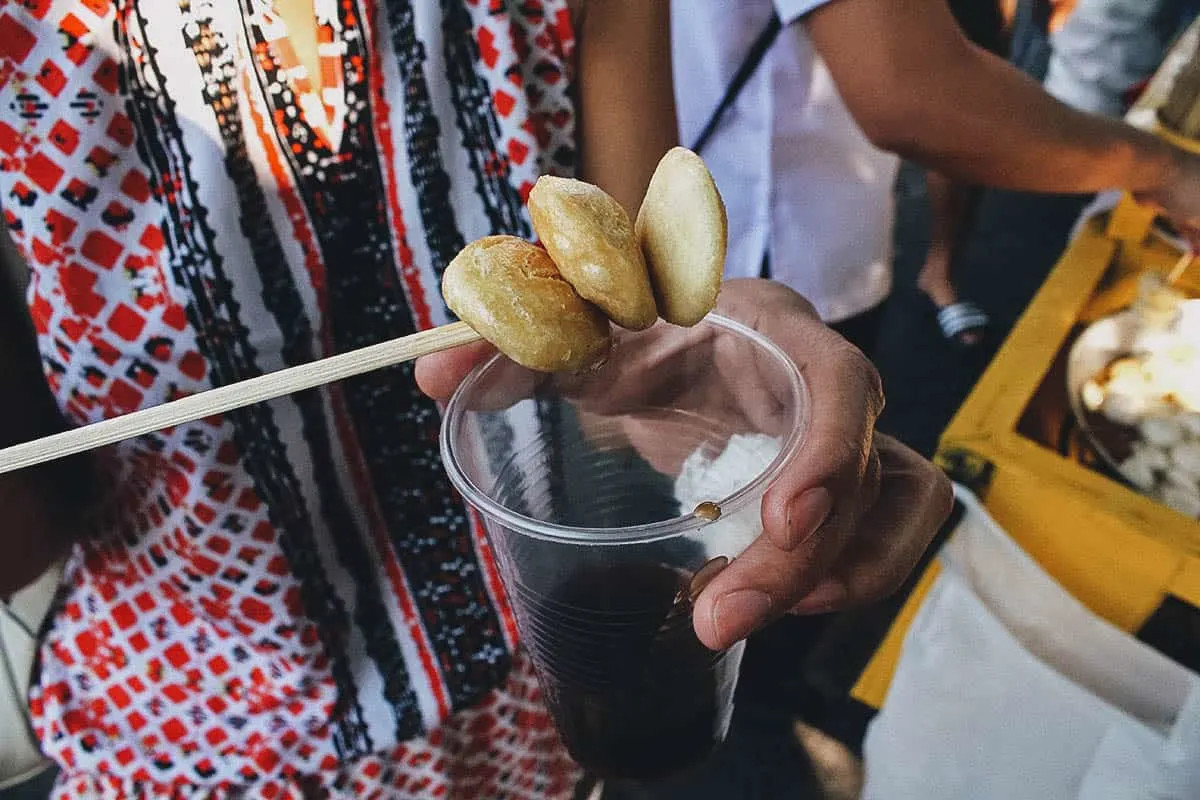 Filipino Fish Balls street food, skewered and ready to be dipped in sauce.
Filipino Fish Balls street food, skewered and ready to be dipped in sauce.
Speaking of street food evolution, chicken balls are a more recent addition. We were surprised to find fish ball vendors now also selling chicken balls. They are larger and almost double the price of fish balls.
Despite not being exactly as I remembered, eating fish balls today flooded me with fond childhood memories. I recall vendors waiting outside our school, frying pans of fish balls sizzling. We’d gather around, spearing fish balls with thin bamboo sticks and dipping them in one of three sauces.
Back then, I didn’t know the sauce ingredients, but one was sweet and brown, another spicy (vinegar with chili), and the third a sweet-spicy combination. I always chose the sweet one. Good times.
 Filipino Chicken Balls street food, larger than fish balls and also skewered for dipping.
Filipino Chicken Balls street food, larger than fish balls and also skewered for dipping.
7. Isaw (Pork or Chicken)
Like fish balls, isaw is another iconic Pinoy street food. While I wasn’t as familiar with it growing up, many consider it a legendary street food, especially around the University of the Philippines Diliman. Students from all walks of life would reportedly line up for isaw at the numerous streetside grill stalls near campus.
Isaw is barbecued pig or chicken intestines, meticulously cleaned, boiled, skewered, and grilled. The picture shows pork isaw on the left and chicken isaw on the right. Like other grilled Pinoy skewers, isaw is typically served with a spiced vinegar dip.
Similar to “walkman” (tenga ng baboy), Filipinos have amusing nicknames for isaw. Chicken isaw is playfully called “I.U.D.” due to its resemblance to older intrauterine device designs. Pork isaw is nicknamed “mag wheels” because of its circular shape!
RECIPE: Grilled isaw
 Skewered Filipino Isaw street food, featuring both pork and chicken intestines grilled to perfection.
Skewered Filipino Isaw street food, featuring both pork and chicken intestines grilled to perfection.
8. Kwek Kwek / Tokneneng
Kwek kwek are hard-boiled quail eggs coated in a vibrant orange batter and deep-fried until crispy. They taste exactly as you’d imagine – eggs deep-fried in a tempura-like batter.
The batter itself is quite bland, so the reason for the orange color is a mystery. Perhaps it’s simply to make kwek kwek more visually appealing? If so, it works.
RECIPE: Kwek-kwek
 Filipino Kwek Kwek street food, featuring deep-fried quail eggs with an orange batter coating.
Filipino Kwek Kwek street food, featuring deep-fried quail eggs with an orange batter coating.
Unlike fish balls, which have been around as long as I can remember, kwek kwek seems to be a relatively newer Pinoy street food, emerging in the last 20 years or so.
Kwek kwek is served with a spicy chili-vinegar dip. It’s also found in some bars, the bite-sized portions making it an ideal Filipino bar snack.
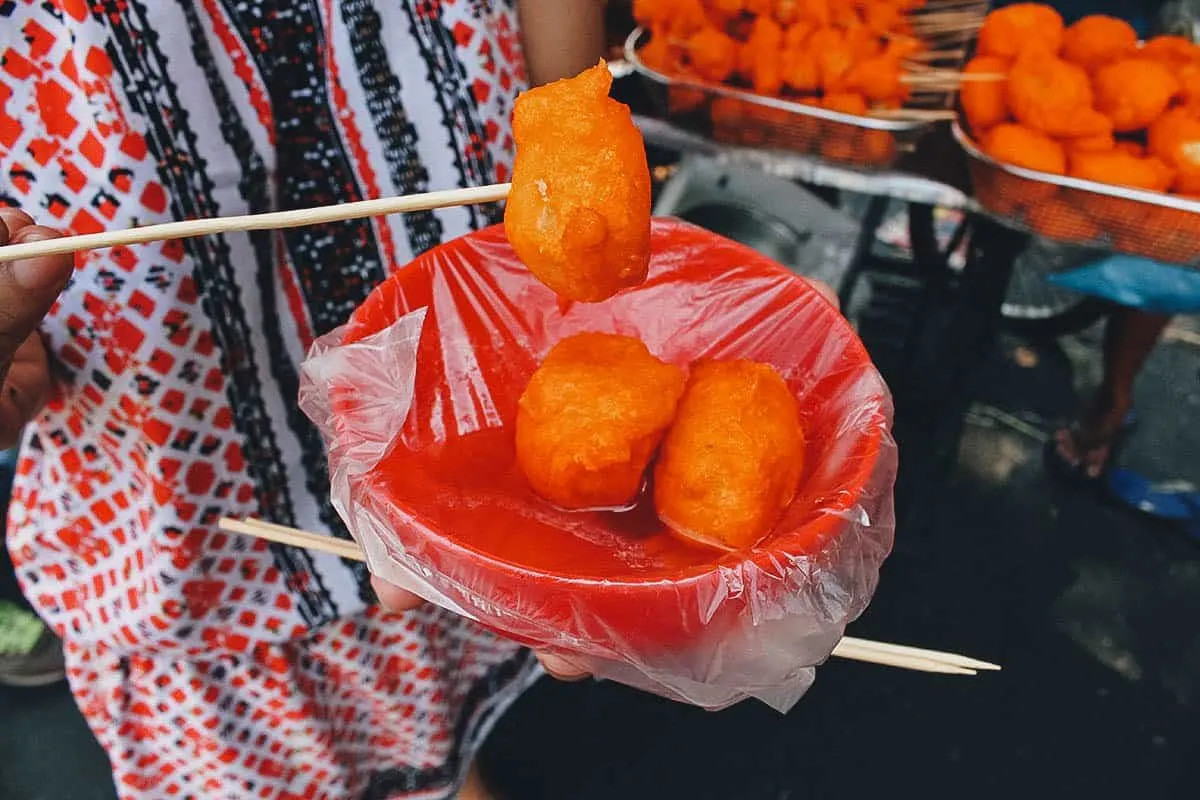 Close-up of Filipino Kwek Kwek street food, showing the crispy orange batter and quail egg inside.
Close-up of Filipino Kwek Kwek street food, showing the crispy orange batter and quail egg inside.
Tokneneng is essentially kwek kwek’s larger sibling, made with hard-boiled chicken eggs instead of quail eggs. It’s the same concept, just a bigger, eggier bite.
 Filipino Tokneneng street food, similar to Kwek Kwek but made with larger chicken eggs.
Filipino Tokneneng street food, similar to Kwek Kwek but made with larger chicken eggs.
9. Lugaw (Goto / Arroz Caldo)
Lugaw is a thick Filipino rice porridge, akin to Cantonese congee. It’s simmered with fresh ginger strips and often topped with scallions, crispy fried garlic, and other seasonings.
Lugaw is a comforting Pinoy street food, also frequently enjoyed at home. I remember my dad often eating it when he wasn’t feeling well.
The term “lugaw” technically refers to plain rice porridge. When enriched with various beef and pork offal like tripe, intestines, and tongue, it becomes “goto.” With chicken, it’s called “arroz caldo.” But essentially, they are all variations of rice porridge.
Whether lugaw, goto, or arroz caldo, I love it best paired with tokwa’t baboy. Tokwa’t baboy is a side dish of boiled pork and deep-fried tofu, seasoned with vinegar, soy sauce, shallots, and chili. This combination is unbeatable on a rainy day. Yum!
RECIPE: Lugaw
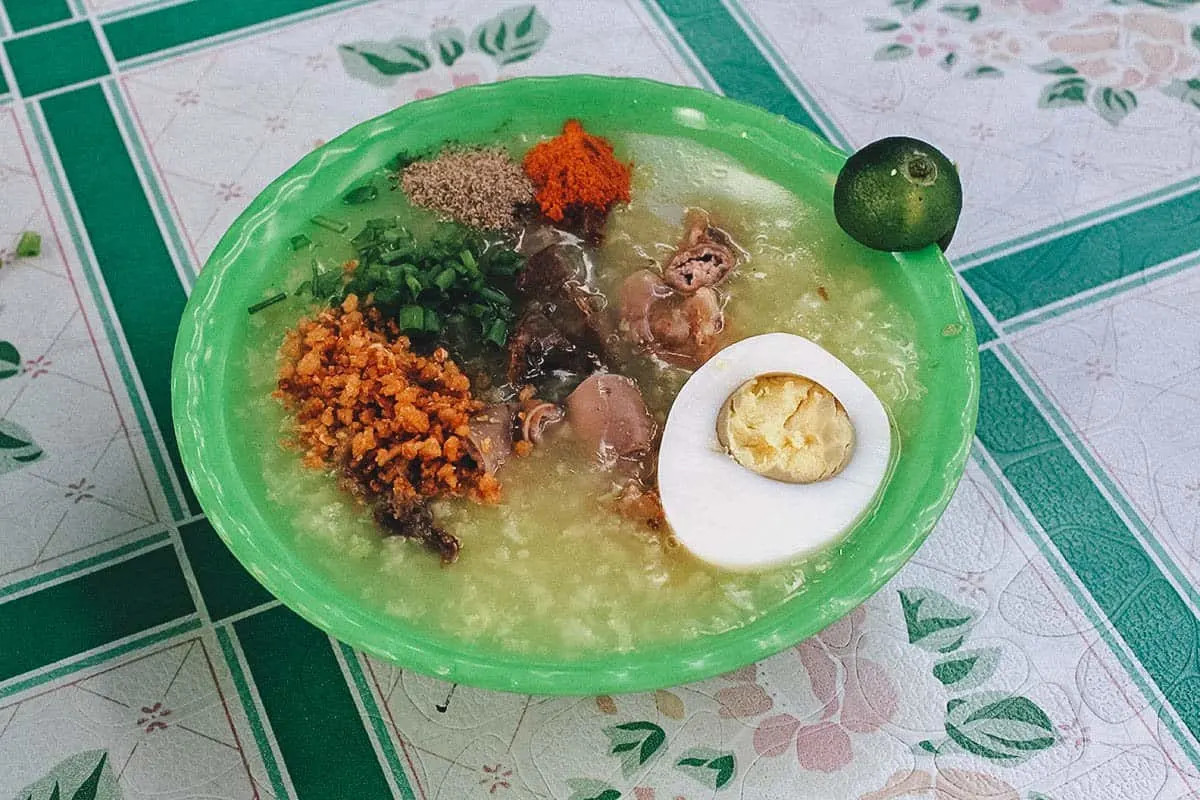 A bowl of Filipino Lugaw street food, a comforting rice porridge with various toppings.
A bowl of Filipino Lugaw street food, a comforting rice porridge with various toppings.
10. Mais
Like buko, I’ve seen mais (corn) sold on Manila streets for as long as I can remember, but I never really considered it street food. Perhaps it’s the simple preparation.
Unlike Mexican elote, which is grilled and seasoned with a creamy sauce, Filipino mais is simply boiled corn on the cob. There’s nothing particularly Filipino about its preparation. But if it’s sold as street food in Manila, then technically it qualifies, hence its inclusion.
RECIPE: Ginataang mais
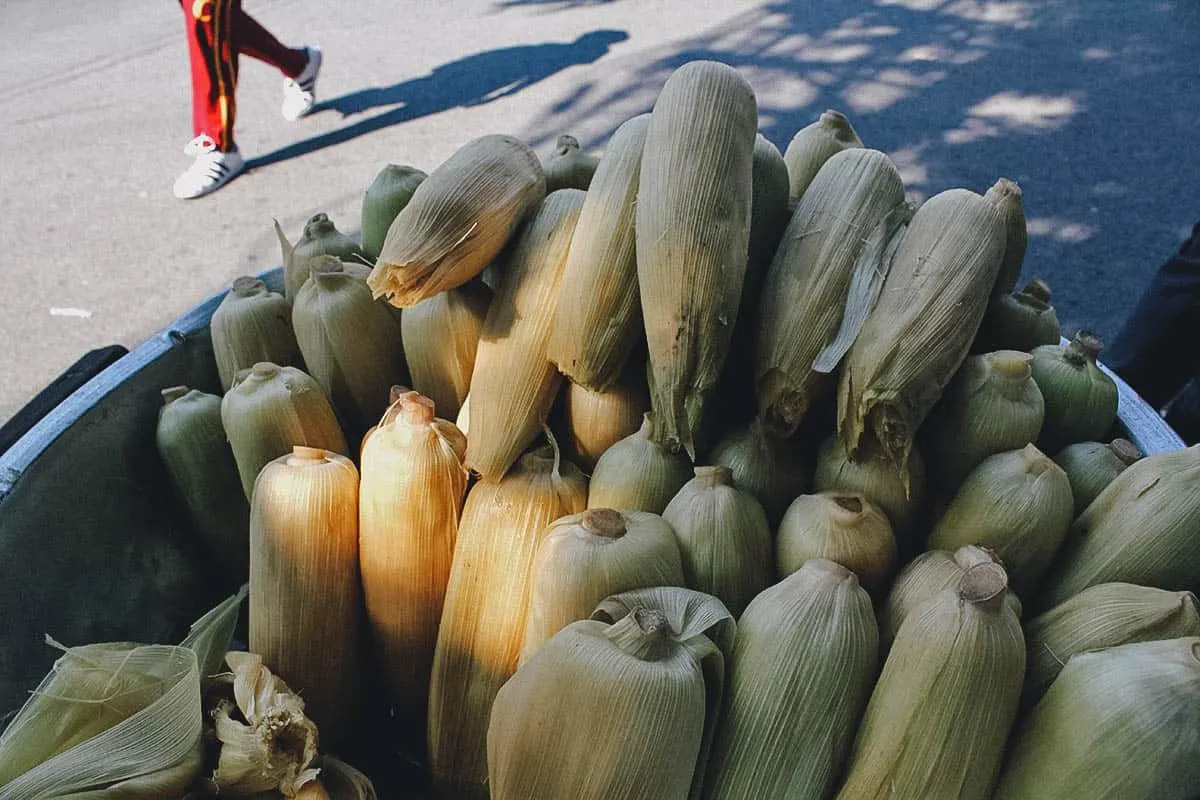 Filipino Mais street food, featuring boiled corn on the cob served simply on the street.
Filipino Mais street food, featuring boiled corn on the cob served simply on the street.
Our mais or boiled corn on the cob. It’s not the most exciting Pinoy street food, but it has its loyal fans. Sometimes, simple is best.
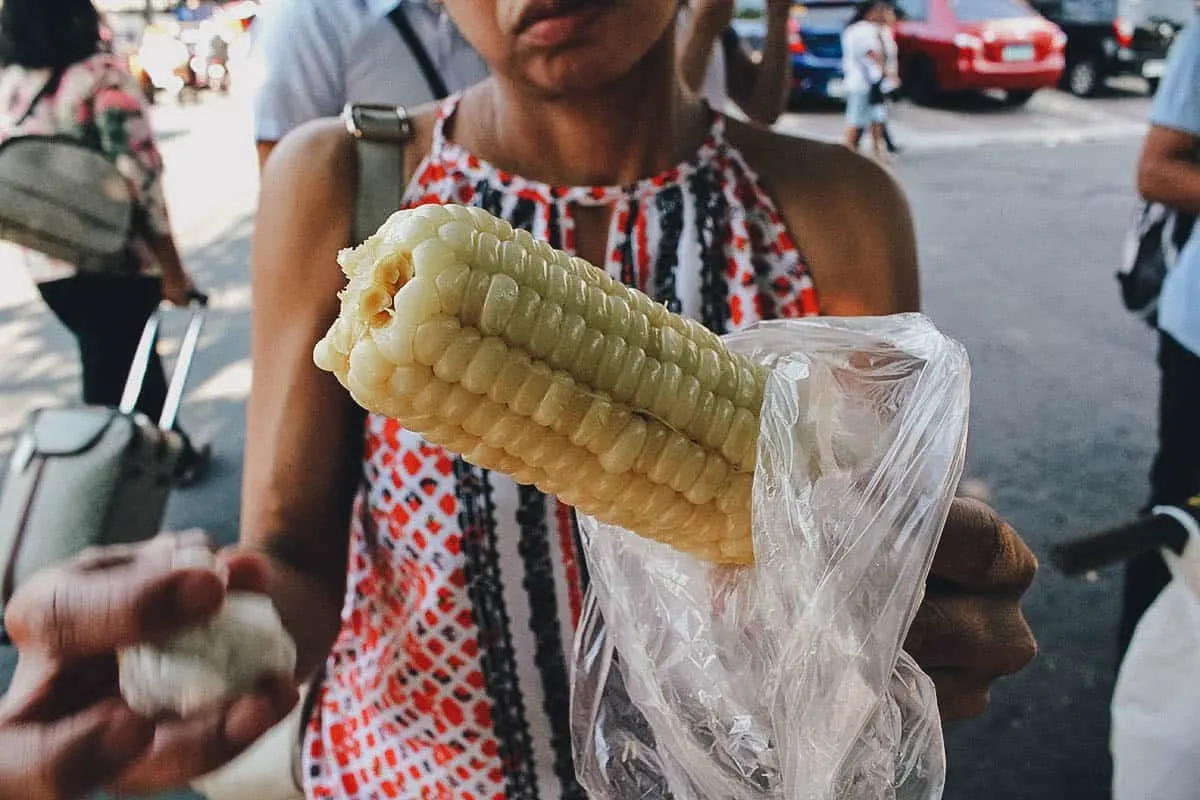 Two cobs of Filipino Mais street food, showing the boiled corn ready to be eaten.
Two cobs of Filipino Mais street food, showing the boiled corn ready to be eaten.
11. Mami
Mami is a Chinese-Filipino noodle soup featuring wheat flour noodles, broth, and meat like beef, chicken, or wonton. To be honest, I never associated mami with street food, thinking it was purely a restaurant dish. But surprisingly, it’s also often sold as street food in Manila.
I recently learned that mami was invented by Ma Mon Luk, a Chinese immigrant who started selling noodles with chicken broth in Binondo, Manila, in the 1920s.
He initially called his dish “gupit,” Tagalog for “to cut,” referring to how he cut the noodles when serving. He later renamed it “mami,” meaning “Ma’s noodles.”
Today, “mami” is the universal term for this noodle soup in restaurants and on the streets.
Growing up in Quezon City, the Ma Mon Luk restaurant along Quezon Avenue was a familiar landmark. Open since the 1950s, it’s a Quezon City institution still thriving today.
Ma Mon Luk passed away in 1961, but his legacy lives on in every comforting bowl of mami. A truly cool piece of culinary history!
RECIPE: Chicken mami
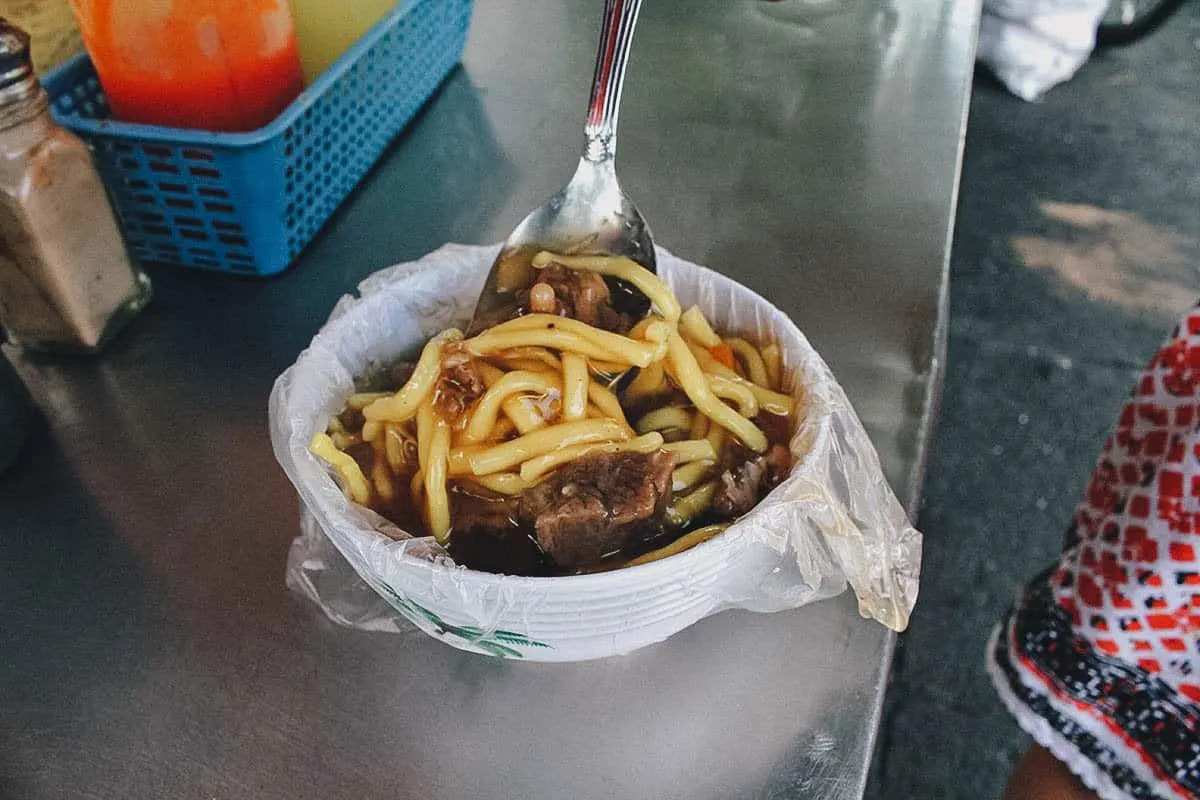 A steaming bowl of Filipino Mami street food, a comforting noodle soup with chicken and broth.
A steaming bowl of Filipino Mami street food, a comforting noodle soup with chicken and broth.
12. Pork BBQ
Pork BBQ is one of the most iconic Filipino dishes. While frequently sold at sidewalk grill stands, earning it the street food label, it’s more than just street food.
Pork BBQ is a Filipino favorite at parties, picnics, and company gatherings. Catered events often feature a chafing dish filled with pork barbecue skewers.
Notably, it’s a children’s party staple, served alongside Filipino sweet spaghetti and red hot dogs.
Pork BBQ consists of marinated pork pieces skewered and grilled over charcoal. They are savory-sweet, smoky, and often slightly charred, offering those delicious dark, crunchy edges.
Typically, a small piece of fat crowns the end of each skewer. Many people leave it, resulting in plates of used skewers with only the fat remaining. I sometimes eat it, depending on its size.
My partner often asks people about their hypothetical last meal: “If you were to die tomorrow, what would you eat tonight?” More than one has answered pork barbecue. It’s a beloved cultural icon that transcends the street food category.
RECIPE: Filipino-style pork bbq
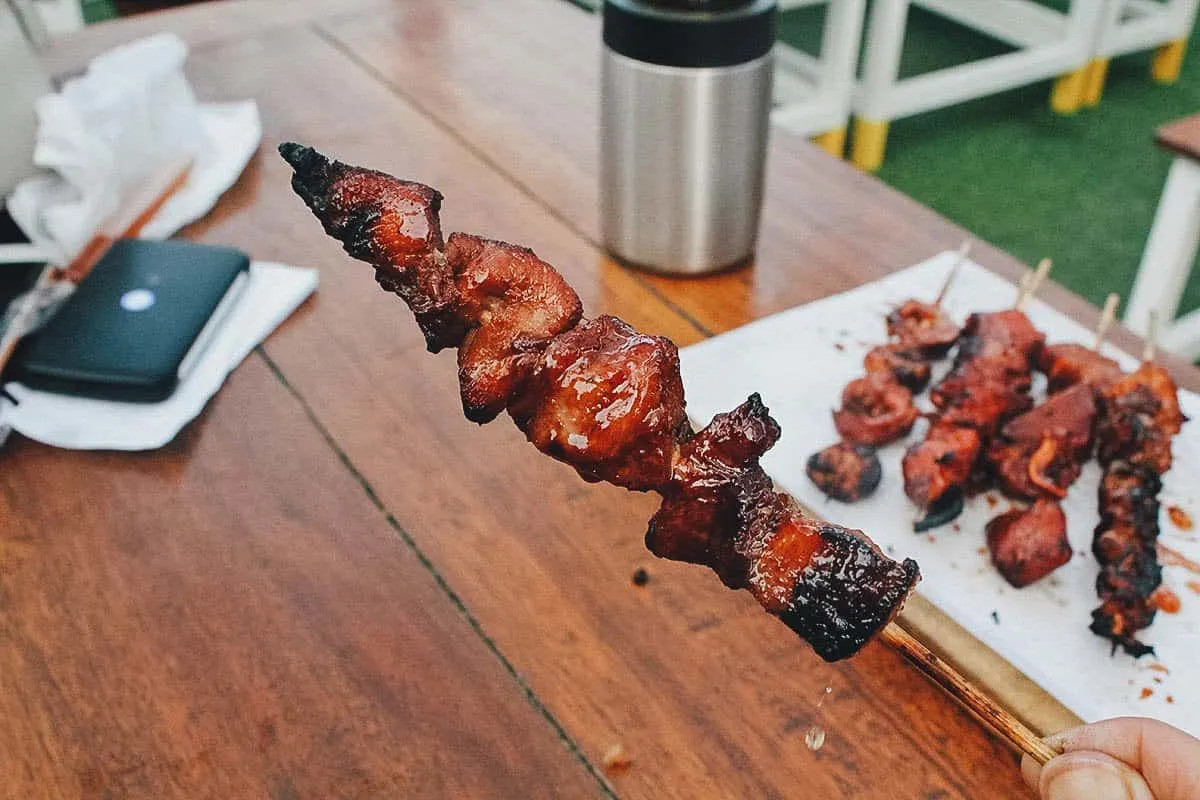 Filipino Pork BBQ street food, featuring marinated pork skewers grilled over charcoal, slightly charred and smoky.
Filipino Pork BBQ street food, featuring marinated pork skewers grilled over charcoal, slightly charred and smoky.
13. Puwet ng Manok
Puwet ng manok literally translates to “chicken butt,” which accurately describes this Pinoy street food – skewered, marinated chicken bottoms. If you haven’t tried chicken butt, it’s a fatty piece of chicken with a soft cartilage strip running through it.
Personally, I’m not a huge fan. I find it too fatty, but many adore it. My sister and partner love it, as does her entire family. At parties, we sometimes bring bags of chicken butts as pulutan (bar snacks).
Because each chicken only has one butt, puwet ng manok can be harder to find. Your best bet is small inasal restaurants.
Inasal is an Ilonggo term for “charcoal grilled” and refers to a specific type of marinated, grilled chicken originating from Bacolod, now popular throughout Manila. In inasal restaurants, puwet ng manok is called isol.
RECIPE: Chicken inasal
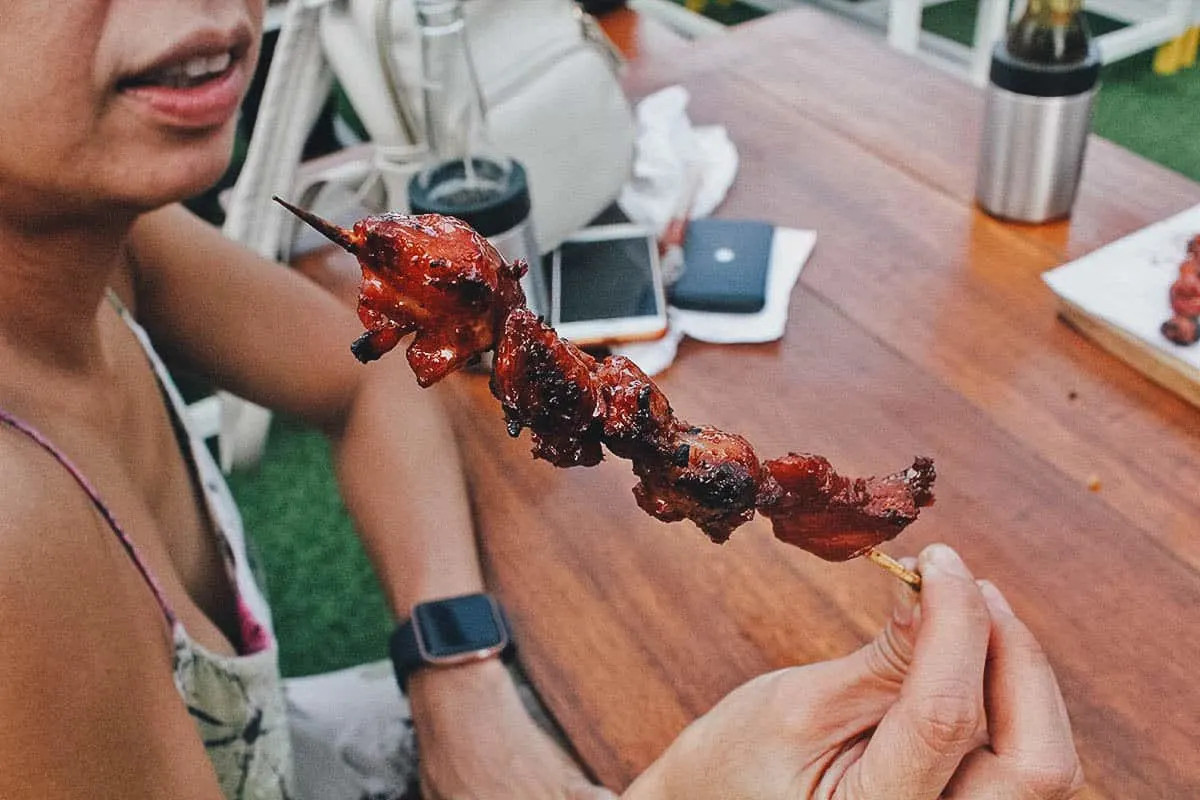 Filipino Puwet ng Manok street food, skewered chicken bottoms grilled and marinated.
Filipino Puwet ng Manok street food, skewered chicken bottoms grilled and marinated.
14. Sorbetes (Dirty Ice Cream)
For me, sorbetes pushcarts are as iconic to Filipino culture as jeepneys. They even resemble jeepneys with their vibrant colors, patterns, and elaborate lettering. I’ve noticed the wheels are often painted yellow, mirroring the sun on the Philippine flag.
Sorbetes is a unique Filipino ice cream. Traditionally made with carabao milk (cheaper than cow’s milk), today both types of milk are used, along with coconut milk and cassava flour. Popular flavors include mango, strawberry, chocolate, ube (purple yam), buko, and my personal favorite, queso (cheese).
RECIPE: Sorbetes
 A colorful Sorbetes cart, showcasing Filipino street ice cream with various flavors.
A colorful Sorbetes cart, showcasing Filipino street ice cream with various flavors.
Sorbetes is also known as “dirty ice cream,” likely due to its street vending context. But the ice cream itself isn’t actually dirty (hopefully!).
Sorbetes melts faster than commercial ice cream, so eat it quickly! Nowadays, commercial brands offer sorbetes-inspired flavors, a nod to this iconic Pinoy street food.
While these commercial versions might be technically superior, nothing beats the experience of enjoying sorbetes on a street corner.
Here’s my partner with a cone of queso sorbetes. If you haven’t tried it, it genuinely tastes like cheese! You even get little cheese bits in the ice cream.
Sorbetes is typically served in small sugar or waffle cones, but it can also be served in bread buns. I haven’t tried it that way, but it actually sounds delicious – a Filipino ice cream sandwich!
 A woman holding a cone of Filipino Sorbetes street ice cream, with the iconic cart in the background.
A woman holding a cone of Filipino Sorbetes street ice cream, with the iconic cart in the background.
15. Tenga ng Baboy (Walkman)
Filipinos are known for giving humorous names to things, especially food, and tenga ng baboy is a prime example. Meaning “pig’s ears,” it refers to skewered, marinated slices of pig’s ears, but it’s colloquially known as “walkman,” after Sony’s iconic cassette player.
Tenga ng baboy reportedly gained street food popularity around the time Walkmans were trendy, hence the name.
Other funny Pinoy street food names include “helmet” (grilled chicken heads) and “adidas” (grilled chicken feet).
Pig’s ears have a unique texture that’s quite addictive – slightly gummy and chewy, with a satisfying snap from the cartilage. It’s really tasty.
RECIPE: Crispy tenga
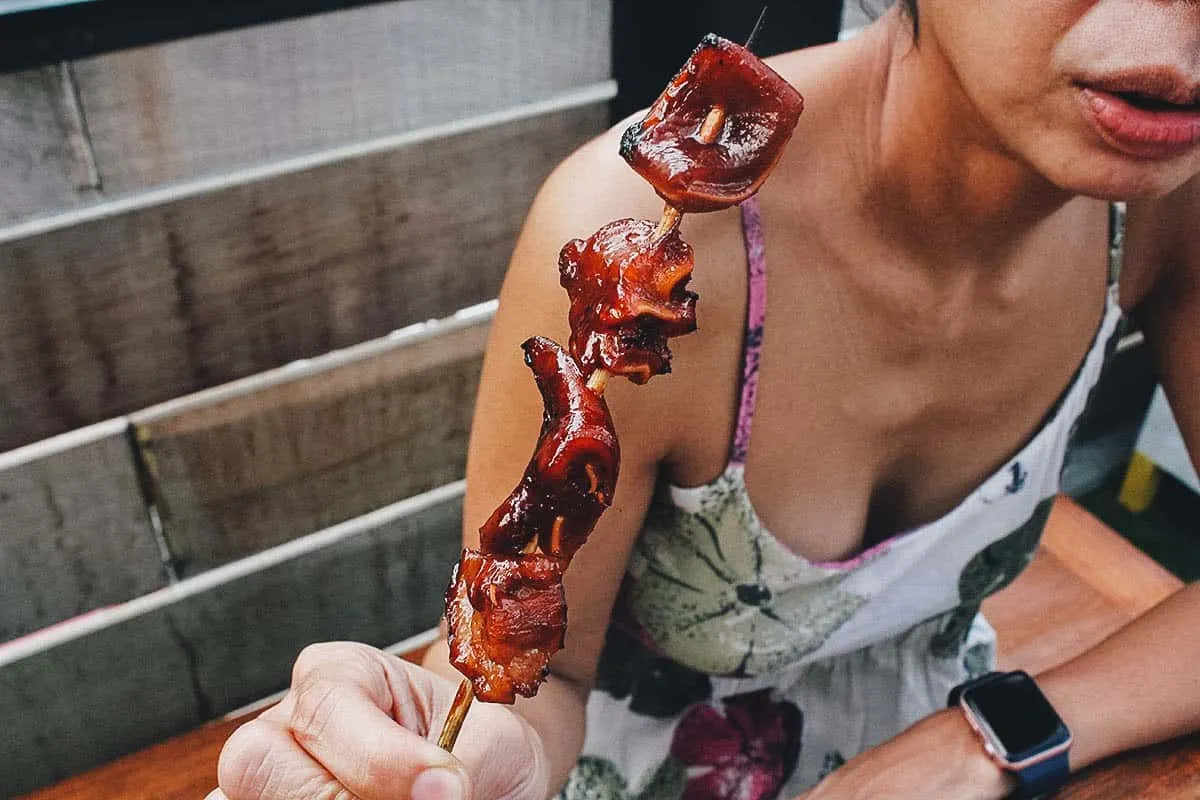 Filipino Tenga ng Baboy street food, skewered and grilled pig ears, also known as Walkman.
Filipino Tenga ng Baboy street food, skewered and grilled pig ears, also known as Walkman.
16. Turon
Along with banana q, turon is the most iconic Pinoy street food made with sweet plantains. It’s a beloved snack, both homemade and street-vended, possibly even more popular due to being lighter and easier to prepare than banana q.
Growing up, turon was served more often than banana q, both as a midday snack and dessert.
RECIPE: Turon
 Filipino Turon street food, featuring sweet plantain spring rolls coated in caramelized sugar.
Filipino Turon street food, featuring sweet plantain spring rolls coated in caramelized sugar.
Here’s our turon with its beautiful caramelized brown sugar coating. Turon is made with thinly sliced saba bananas, rolled in spring roll wrappers, dusted with brown sugar, and deep-fried.
This particular turon didn’t have any, but often turon includes a sliver of langka or jackfruit, which I prefer.
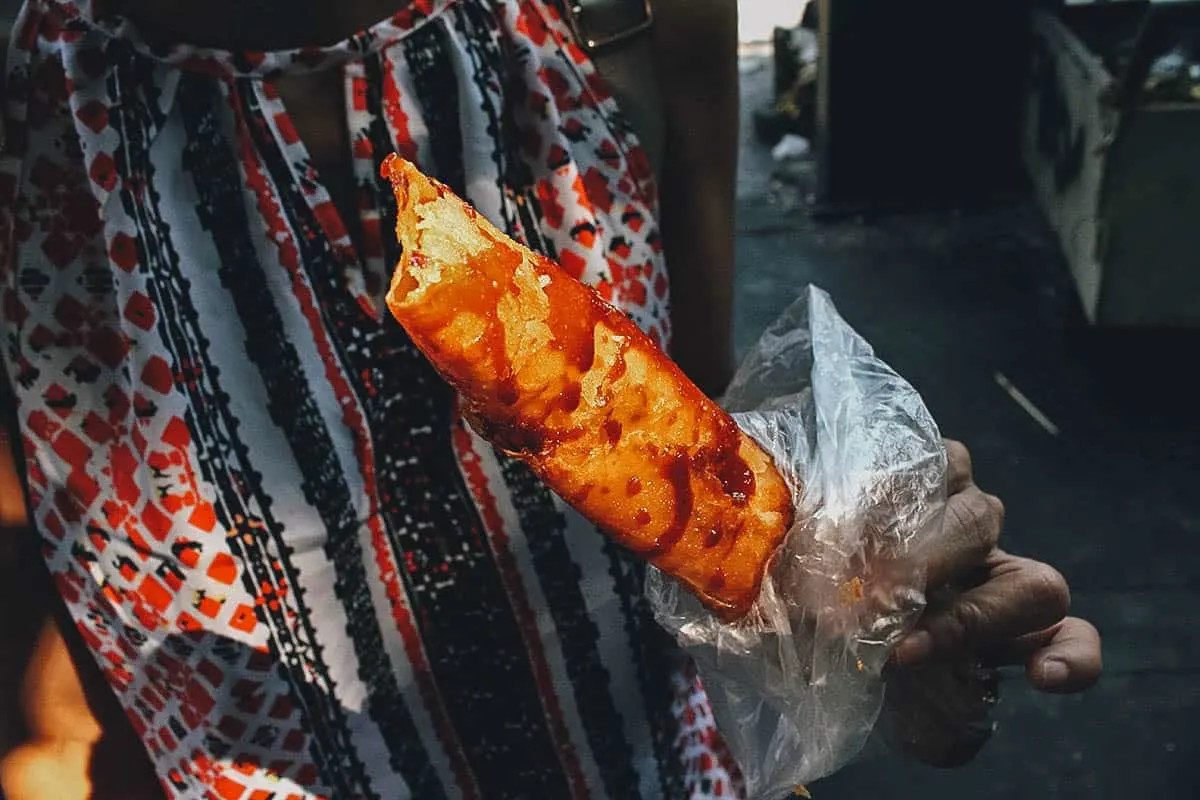 Close-up of Filipino Turon street food, highlighting the caramelized sugar and spring roll wrapper.
Close-up of Filipino Turon street food, highlighting the caramelized sugar and spring roll wrapper.
A closer look at the delicious sweet plantain filling within the crispy wrapper.
 Inside a Filipino Turon street food, showing the cooked sweet plantain filling.
Inside a Filipino Turon street food, showing the cooked sweet plantain filling.
17. Ukoy (Okoy)
Ukoy (or okoy) are Filipino shrimp fritters. Made with small shrimp, often with heads and shells intact, mixed in batter and deep-fried until crispy.
The ukoy we had contained only shrimp, but many variations include vegetables like mung bean sprouts and julienned squash.
One of the most famous regional versions is Vigan ukoy from Ilocos Sur, made with glutinous rice flour and spring onions, offering a unique texture and flavor.
RECIPE: Ukoy
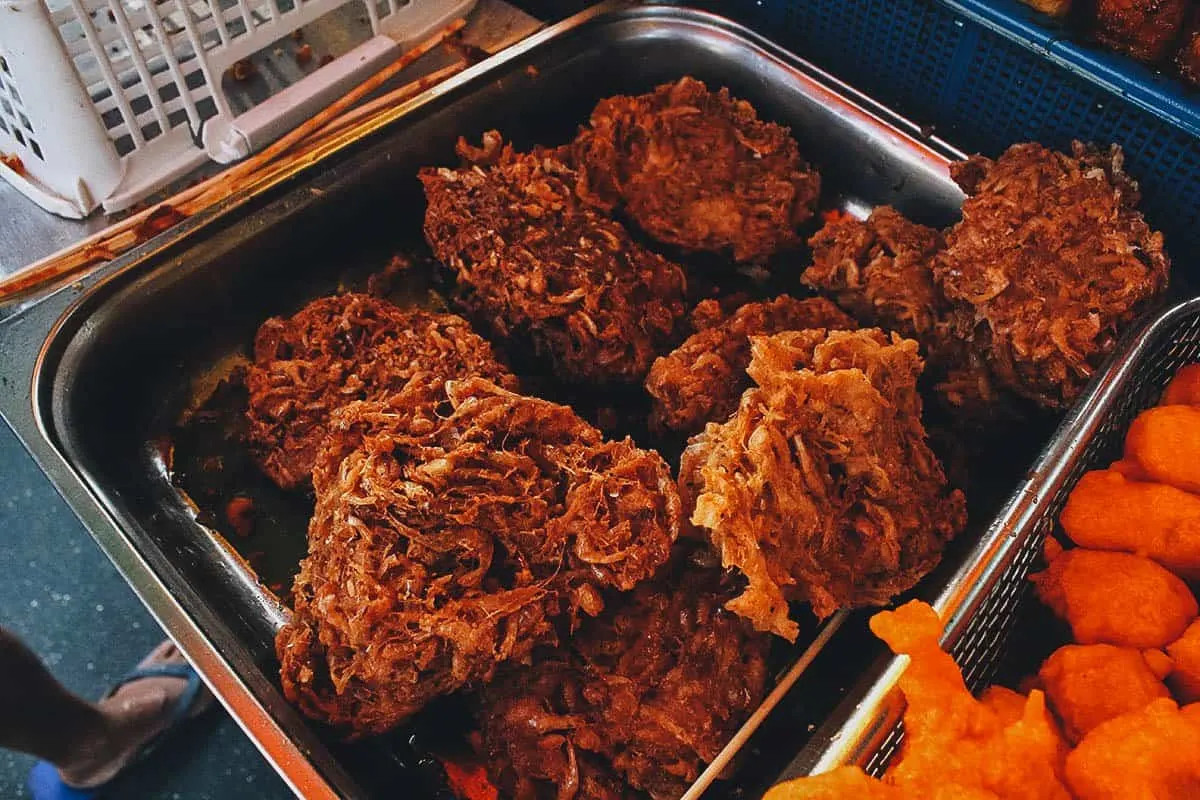 Filipino Ukoy street food, crispy shrimp fritters often served with vinegar dip.
Filipino Ukoy street food, crispy shrimp fritters often served with vinegar dip.
Ukoy is traditionally eaten with spiced vinegar to balance the oiliness. It’s a crunchy, savory snack also found in many Filipino restaurants. Personally, I enjoy it with rice as a meal.
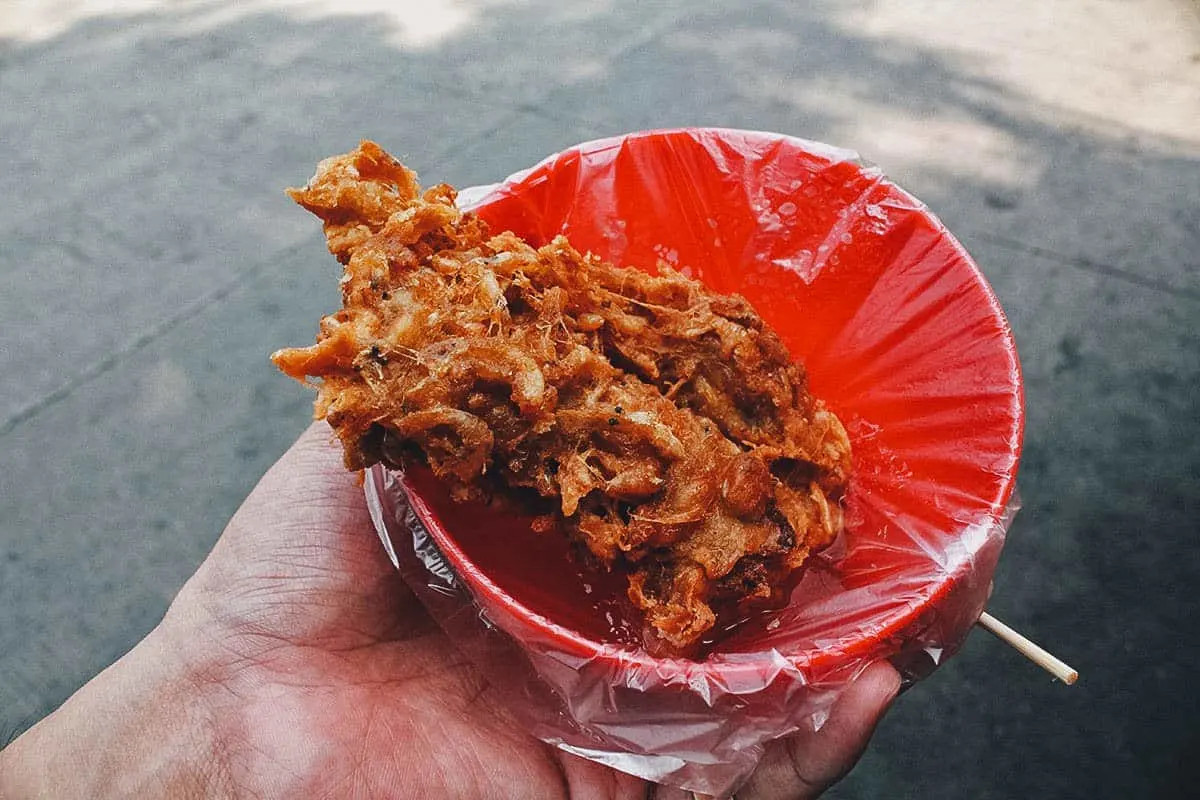 Close-up of Filipino Ukoy street food, showcasing the crispy texture and shrimp details.
Close-up of Filipino Ukoy street food, showcasing the crispy texture and shrimp details.
Final Thoughts on Pinoy Street Food
So, what did we learn from our Pinoy street food adventure? Did we get sick? Did we regret it? The answers are no, no, and absolutely not!
We discovered that Pinoy street food is neither cleaner nor dirtier than street food in other Southeast Asian countries. Were we wrong to dismiss Pinoy street food before? Yes, definitely. Were our safety concerns entirely unfounded? I’m still not entirely sure.
By its very nature, street food might seem less hygienic than restaurant fare. However, an article on street food suggests that contamination rates in street food are comparable to restaurants.
While I’m unsure how directly these findings apply to the Philippines, the study’s environments (Ghana and Calcutta) are similar. It was surprising to consider.
Ultimately, we don’t know every detail of Pinoy street food production. We hear stories and make assumptions, but that’s all they are – assumptions.
I’m not saying these assumptions are always wrong. But if we happily eat street food abroad without worry, we should extend the same openness to Pinoy street food. It’s essentially the same culinary world.
We enjoyed “researching” for this post so much that we plan to expand this list over time. If you know Pinoy street food, you’ll realize this list is far from complete. Still missing are iconic dishes like betamax, adidas, helmet, day old chicks, halo-halo, kakanin, taho, and many more delicious discoveries waiting to be made.

